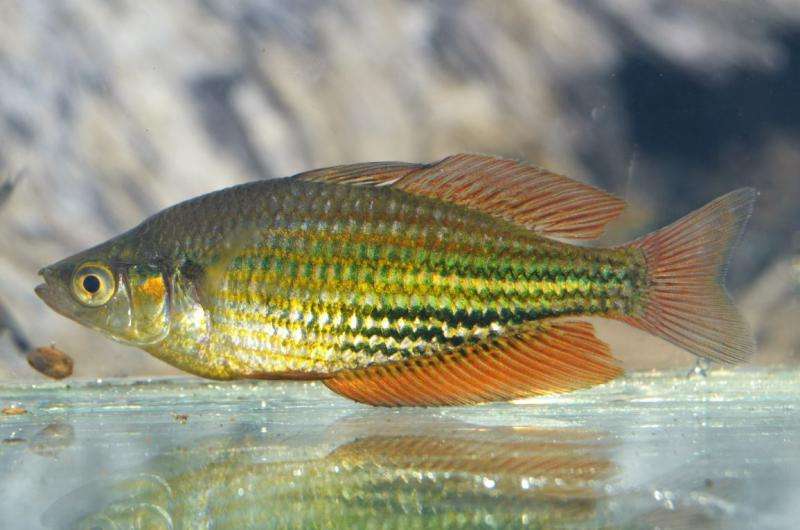DNA match-making for endangered animals in captivity

Researchers at Flinders University have created SWINGER, computer software with an algorithm that uses information from DNA to match-make endangered animals for captive breeding.
Popular online dating services such as OkCupid and eHarmony use algorithms to help people find love. The user answers ready-made questions and the algorithm extrapolates how well that user matches other users who have answered those questions.
Can such an algorithm be implemented to also increase the success of captive breeding in endangered species? A need for such an algorithm is growing as human-caused extinctions are on the rise. Many species are likely to require captive breeding to ensure their survival.
One cannot ask a snake, fish or possum to answer questions in order to match up individuals. However, one can look at their DNA.
"We use DNA to work out otherwise unobservable family relationships. Our matchmaking algorithm then takes this information and uses it to design breeding groups consisting of the least related individuals," says Dr Jonathan Sandoval-Castillo, the main program developer and postdoctoral fellow at Flinders School of Biological Sciences.
"This allows genetically healthy offspring and the maintenance of genetic diversity," he says.
"Genetic diversity is important to conserve as it has developed through evolution, making a species what it is now. It allows individuals of that species to survive, reproduce, and adapt to environmental changes," says Professor Luciano Beheregaray, who leads the Molecular Ecology Laboratory at Flinders.
The software is freely available from the Molecular Ecology group's webpage www.molecularecology.flinders.edu.au for the use of any conservation manager or biologist.
How have captive breeding programs managed to maintain genetic health to date?
"Many species kept in zoos – such as charismatic mammals like pandas – have easy to observe family relationships or are bred in pairs and so parentage is certain," says fellow molecular ecologist Dr Catherine Attard. "So there was no need of an algorithm such as ours. Zoos can keep track of the pedigrees and use them to decide new, unrelated breeding pairs."
However, most animals in the world are polygamous, with each individual naturally having multiple partners, even around the same time. This is where it becomes problematic to keep track of family relationships without the use of DNA.
Dr Sandoval-Castillo adds: "It is also often more difficult to work out the best polygamous breeding groups, as opposed to monogamous breeding pairs, because you have more than two individuals involved. It is in this common situation where our algorithm thrives."
The matchmaking algorithm is also ideal for starting a captive breeding program from individuals newly brought into captivity. This is because we often have no idea about their relationships to each other, except through DNA, and they may be highly related individuals.
"The very circumstances that brought about the need for captive breeding also often results in inbreeding in wild populations. This is because the population has reduced in size to the point that individuals may unavoidably breed with related individuals," Dr Attard says.
Even when dealing with such serious issues as extinction, scientists maintain a sense of humour. The software has been jokingly named SWINGER to refer to the human sexual practice of swinging, especially given that individuals of most species in the world are naturally polygamous.
The first endangered species being saved using the matchmaking algorithm is a rare lineage of rainbowfish that is only found in the Running River in northern Queensland.
The Running River rainbowfish is morphologically and genetically distinct from any other rainbowfish, and so it is likely to be a new species to science. However, it is being swamped out of existence by the illegal introduction of the abundant eastern rainbowfish species Melanotaenia splendida into the Running River.
Working with Dr Peter Unmack from the University of Canberra, who is leading the effort to save the Running River rainbowfish, the Flinders University team formed 17 breeding groups of these fish from wild-caught individuals using the fish's DNA and the matchmaking algorithm of SWINGER.
Dr Unmack says: "The breeding groups have been highly successful, producing thousands of fingerlings that we have begun releasing to the wild. It is still a work in progress, but it is looking positive. We and native fish aquarists continue to keep populations in captivity, just in case. But to truly preserve nature, we need to restore the fish in the wild."
"Hopefully in the future there will be 'plenty of fish' in the wild for the Running River rainbowfish," says Dr Sandoval-Castillo, the lead author on the recently published scientific paper published online at the leading journal Molecular Ecology Resources.
More information: Jonathan Sandoval-Castillo et al. SWINGER: a user-friendly computer program to establish captive breeding groups that minimize relatedness without pedigree information, Molecular Ecology Resources (2016). DOI: 10.1111/1755-0998.12609
Journal information: Molecular Ecology Resources
Provided by Flinders University



















